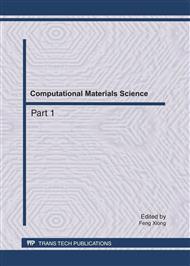[1]
K. Wagstaff, C. Cardie, S. Rogers, S. Schroedl. Constrained K-means clustering with background knowledge. In: Proc. of the 18th Int'l Conf. on Machine Learning. Williamstown: Morgan Kaufmann Publishers, (2001), 577-584.
Google Scholar
[2]
S. Basu, A. Banerjee, R.J. Mooney. Semi-Supervised clustering by seeding. In: Proc. of the 19th Int'l Conf. on Machine Learning. Sydney: Morgan Kaufmann Publishers, (2002), 19-26.
Google Scholar
[3]
M. Bilenko, S. Basu, R.J. Mooney, Integrating constraints and metric learning in semi-supervised clustering, in: Proceedings of International Conference on Machine Learning, (2004), 81-88.
DOI: 10.1145/1015330.1015360
Google Scholar
[4]
S. Basu, M. Bilenko, R. J. Mooney. A Probabilistic Framework for Semi-Supervised Clustering. In: Proceedings of the tenth ACM SIGKDD international conference on Knowledge discovery and Data Mining, (2004), 59-68.
DOI: 10.1145/1014052.1014062
Google Scholar
[5]
W. Tang, H. Xiong, S. Zhong, J. Wu. Enhancing semi-supervised clustering: a feature projection perspective. In: Proceedings of the International Conference on Knowledge Discovery and Data Mining, (2007), 707-716.
DOI: 10.1145/1281192.1281268
Google Scholar
[6]
X.S. Yin, Q. Huang. Integrating Global and Local Structures in Semi-supervised Discriminant Analysis. The Third International Symposium on Intelligent Information Technology Application, (2009), 757-761.
DOI: 10.1109/iita.2009.323
Google Scholar
[7]
B. Kulis, S. Basu, I. Dhillon, R.J. Mooney, Semi-supervised graph clustering: a kernel approach, in: Proceedings of the 22st International Conference on Machine Learning, (2005), 457-464.
DOI: 10.1145/1102351.1102409
Google Scholar
[8]
B. Yan, C. Domeniconi, An adaptive kernel method for semi-supervised clustering, in: Proceedings of the 17th European Conference on Machine Learning, Berlin, Germany, (2006), 18-22.
Google Scholar
[9]
X.S. Yin, S.C. Chen, E.L. Hu, D.Q. Zhang. Semi-supervised clustering with metric learning: An adaptive kernel method. Pattern Recognition, 43(4): 1320-1333 (2010).
DOI: 10.1016/j.patcog.2009.11.005
Google Scholar
[10]
B.Y. Kang, S. Ko, D. Kim. SICAGO: Semi-supervised cluster analysis using semantic distance between gene pairs in Gene Ontology. Bioinformatics, 26 (10): 1384-1385 (2010).
DOI: 10.1093/bioinformatics/btq133
Google Scholar
[11]
R. Filipovych, S.M. Resnick, C. Davatzikos. Semi-supervised cluster analysis of imaging data. NeuroImage, 35(10): 1168-1179 (2010).
DOI: 10.1016/j.neuroimage.2010.09.074
Google Scholar
[12]
E. Yasunori, H. Yukihiro, Y. Makito. On semi-supervised fuzzy c-means clustering. IEEE International Conference on Fuzzy Systems, 2009, 1119-1124.
DOI: 10.1109/fuzzy.2009.5277177
Google Scholar
[13]
T. Luis, B. Chitta, K. Seungchan. Fuzzy c-means clustering with prior biological knowledge. Journal of Biomedical Informatics, 42(1): 74-81 (2009).
Google Scholar
[14]
N. Grira, M. Crucianu, N. Boujemaa. Active Semi-Supervised Fuzzy Clustering, Pattern Recognition. 41(5): 1851-1861 (2008).
DOI: 10.1016/j.patcog.2007.10.004
Google Scholar
[15]
D.Q. Zhang, K.R. Tan, S.C. Chen. Semi-supervised kernel-based fuzzy c-means. In: Proceedings of the International Conferences on Neural Information Processing (ICONIP'04), India, LNCS3316, (2004), 1229-1234.
DOI: 10.1007/978-3-540-30499-9_191
Google Scholar
[16]
H. Zhang, J. Lu. Semi-supervised fuzzy clustering: A kernel-based approach. Knowledge-Based Systems, 22(6): 477-481 (2009).
DOI: 10.1016/j.knosys.2009.06.009
Google Scholar
[17]
E.P. Xing, A.Y. Ng, M.I. Jordan, S. Russell, Distance metric learning, with application to clustering with side-information, in: Advances in NIPS, MIT Press, Cambridge, MA, USA, (2003), 505-512.
Google Scholar
[18]
S. Xiang, F. Nie, C. Zhang. Learning a Mahalanobis distance metric for data clustering and classification. Pattern Recognition, 41(12): 3600-3612 (2008).
DOI: 10.1016/j.patcog.2008.05.018
Google Scholar
[19]
J.C. Bezdek. Pattern recognition with fuzzy objective function algorithms, Plenum Press, (1981).
Google Scholar
[20]
http: /www. ics. uci. edu/~mlearn/MLRepository. html.
Google Scholar


